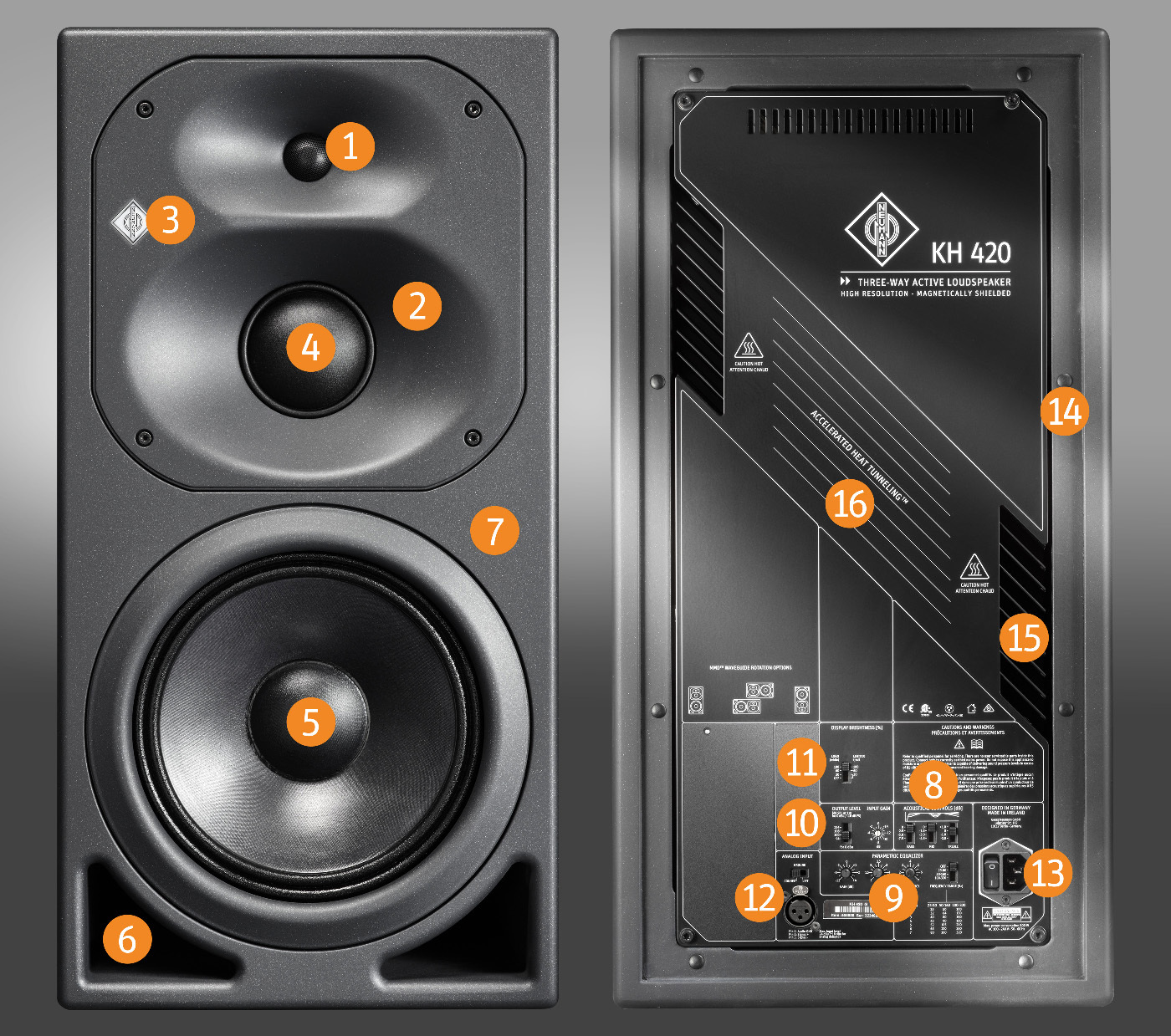We're Always Here To Help
Reach out to us through any of these support channels
Product Code:KH420G

The KH 420 is a three-way tri-amplified monitor with thermally protected Class AB amplifiers (330 W and two times 140 W). Just like the drivers, its Mathematically Modeled Dispersion™ (MMD™) waveguide is engineered for optimum precision. Sound distributed in a horizontally precise manner ensures flexibility in the listening position; the narrower vertical dispersion reduces the negative effects of nearby reflections, for example from a desk or mixing console. The dispersion of the KH 420 is deliberately designed to be narrower, to guarantee reference sound at longer working distances.
The KH 420 is designed for a working distance of 1.5 to 3 m (5’ to 9’). It handles this space effortlessly thanks to great power reserves and precisely concentrated dispersion. Even in diverse acoustical environments the KH 420 remains neutral and clear in every detail down to the subtlest nuances. No subtlety is lost; every sound element can be localized.
The KH 420 is designed for midfield applications and as main monitor in project, music, broadcast and post-production studios for recording, mixing and mastering. And in a multi-channel system, it can also be freely combined with all other Neumann studio monitors.
With its tri-channel amplifiers the KH 420 also realizes sound pressures of up to 122.4 dB. And it thereby retains high-resolution and neutral representation across the entire frequency response. This also includes an exceptional bass response down to 26 Hz. Despite using ports, there is no “overhang” or audible resonance in the low frequency range and the transient response is precisely controlled at all times.
The computer modeled chassis is constructed of LRIM™ materials which eliminates standing wave resonances and suppresses intermodulation distortion, especially in the midrange.
For demanding treble, our own specially developed, powerful alloy fabric dome ensures distortion-free reproduction. The fabric dome captures the midrange with utmost precision. Its ultralight material and the powerful neodymium magnet enable a significantly better transient response with considerably less distortion than comparable midrange drivers.
The Digital Input Module DIM 1 expands the loudspeaker electronics by a digital XLR input, a digital BNC input and a digital BNC output (192 kHz/24 Bit) for flexible digital signal links. With the delay function (adjustment range 0 - 400 ms) of the DIM 1, the audio signal can be delayed to ensure audio-visual synchronization (lip sync). In addition, the high resolution of the delays (0.1 ms) allows equalization of the propagation delays. The delay can be added to both inputs (digital and analog). The KH 420 can be retrofitted with a DIM 1.
In addition to its outstanding acoustic properties this subwoofer offers functions for non DSP-based Neumann monitors connected (analog) to its outputs regarding the interplay with the following tools:

(1)
In-house simulated tweeter with alloy fabric dome and robust metal grille
(2)
Rotatable elliptical Mathematically Modelled Dispersion™ (MMD™) waveguide
Wide horizontal dispersion
Narrow vertical dispersion
(3)
Two-color + dimmable Neumann logo
(4)
In-house simulated, neodymium magnet, fabric dome, midrange driver with optimized low stray magnetic field
(5)
In-house modelled long-throw composite sandwich cone bass driver with Extremely Linear Force Factor™ (ELFF™), magnetic shielding and flow optimized die cast basket
(6)
Large high-capacity flow-optimized bass reflex ports with pipe resonance damping
(7)
Computer mechanically modeled three-way cabinet design using Low resonance Integral Molding™ (LRIM™) materials
(8)
4-position bass, low-mid and treble acoustical controls
(9)
Parametric equalizer
(10)
Wide range input gain and output level controls
(11)
Display dimmer
(12)
XLR electronically balanced analogue input with ground lift
(13)
Universal dual (bass and mid/treble) switched-mode power supplies (100 … 240 V)
(14)
Fully documented extensive mounting hardware range
(15)
Electronics panel with generously dimensioned integrated Accelerated Heat Tunneling™ (AHT™) heat sink
Installation flexibility
(16)
Powerful amplifiers with large headroom and overheat limiting
Separate fast acting thermo limiters for woofer, midrange and tweeter to protect the voice coils and power amplifiers
Production consistency due to individual hand alignment in final testing
Optional robust metal grille